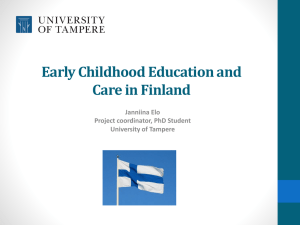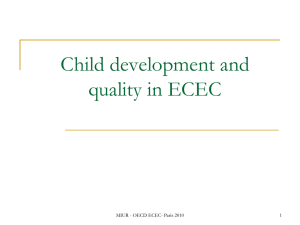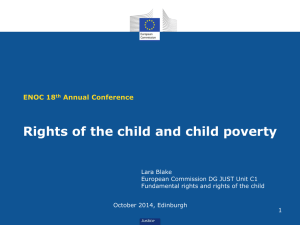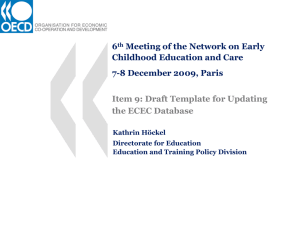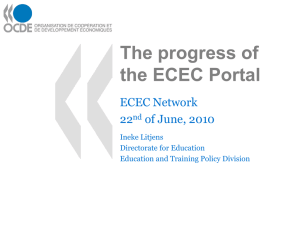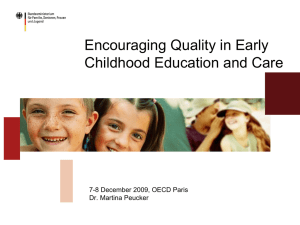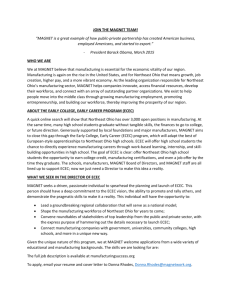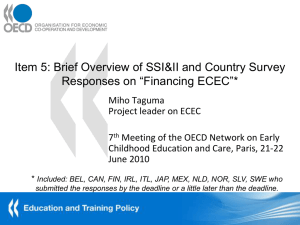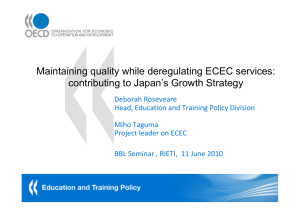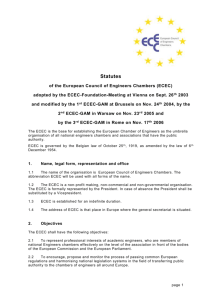Question
advertisement
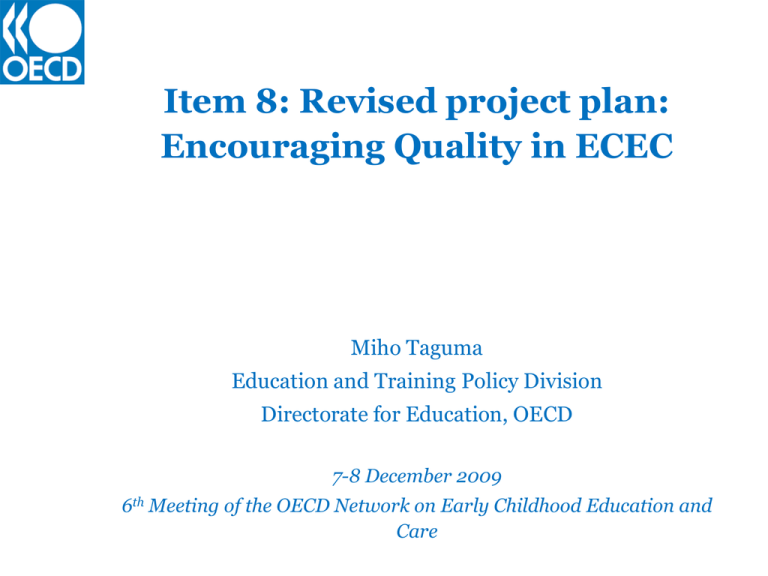
Item 8: Revised project plan: Encouraging Quality in ECEC Miho Taguma Education and Training Policy Division Directorate for Education, OECD 7-8 December 2009 6th Meeting of the OECD Network on Early Childhood Education and Care Refining the project • Scoping of the project • Output types • Participation and costs Scoping of the project Agreed target levels: • Cover Age 0-6 in order to further uncover the complex arrangements and add value to international comparison. Agreed point of departure: Starting Strong I & II • Drawing on SSI&II and going beyond (i.e. policy orientations/ recommendations through policy reviews) • Focusing on “implementation” Agreed overarching policy question: How can countries put in place policies that would raise quality in ECEC? Framework: • Policies • Quality indicators and quality in child outcomes • Implementation factors Descriptive/Analytical questions: • How can ‘quality’ be defined in ECEC? (Mapping of quality indicators in Annex 3) • What factors (of the quality indicators) can enhance well-being and learning outcomes? • Where can policies make a difference in child outcomes, affecting these factors? What are the relationships between the core quality indicators and child outcomes, over time and by varied ECEC types? • What are the strategies, practical tools, checklists, etc that can help countries to implement these policies? • Under what conditions can such strategies and tools be used effectively? What are the success factors and obstacles for effective implementation of these policies? Question: • Do you find these questions most relevant to answer the overarching question of the project? 1. 2. 3. 4. 5. 6. 7. 1. 2. 3. 4. 5. 6. 7. 1. 2. Governance, co-ordination and management Take a systemic and integrated approach to policy development and implementation. Provide autonomy, funding and support to early childhood services. Funding Provide substantial public investment in services and the infrastructure. Research, evaluation, monitoring and data collection Place systematic attention to monitoring and data collection. Workforce Improve the working conditions and professional education of ECEC staff. Organisation, curriculum and pedagogy Develop broad guidelines and curricular standards with the stakeholders for all ECEC services. Question: Encourage family and community involvement in early childhood services. Policies Tools Implementation & Success factors/ obstacles Strategies e.g. Stakeholder buy-in, political commitment at national and local level, sufficient time, adequate • How do you assess the policy developments onfunding, the 7 identification of policy orientations in your country? parental needs Protection, care and safety (e.g. space requirements, facility safety, etc.) • Which one(s) are currently on your policy agenda Quality indicators first,as etc.a Health and nutrition (e.g. presence of medical care, toileting procedures, etc.) priority linked raising quality ECEC? Staffing, training and working conditions (e.g.to qualifications, staff/childinratio, salaries, etc.) Legislations, regulations, funding (standards of operations, government spending, access, etc.) Curriculum and pedagogy (e.g. national Relationships with children) Parental and community engagement (e.g. family participation in activities, etc.) Evaluation and monitoring (e.g. parental satisfaction, education outcomes, early identification) Child well-being (DELSA) Cognitive and non-cognitive (socio-emotional) outcomes (e.g. school readiness results, etc.) Outcomes Politics, public opinions, long traditions, conflicts interest groups, etc… Output types 1. 2. 3. 4. Policy tool box Country-specific policy profile Policy forum(s) Roundtable discussion on implementation Output type 1: Policy Tool Box • Aim: to present “practical solutions” on implementation • Rationale: “Evidence is most helpful when it is fed back to Question: institutions along with information and tools about how they • Will output type be(CEO useful for your country? can this use the information.” meeting on PER in 2008) • • Are thereWill other suggestions for what to include, which Output: include “what” & “how”: will be more useful for countries? – Definitions & indicators for quality in use – Factors that may affect child well-being and learning outcomes – The 7 selected policy orientations (to confirm) – Tools, strategies, checklists, materials, etc that will help countries to put in place these policies Output type 2: Country-specific policy profile • Aim: to provide the most relevant data from the OECD, highlighting a country in comparison with other OECD countries Question: • Rationale: Need for policymakers “to build consensus on the aims of education reform and actively engage stakeholders…in formulating and implementing the • Will this be useful for your country? policy responses.” (CEO meeting on PER in 2008) To obtain stakeholder a strong casefor should be made with relevant • • Are there otherbuy-in, suggestions what to out include, which information, especially compelling evidence. will be more useful for your country? • The OECD work has multidisciplinary data/ information on ECEC within EDU and in other directorates like DELSA. The secretariat can “repackage” data/information to be most useful for the country concerned • Output: will be presented on the selected policy: – Factsheets with relevant statistics, highlighting the country in the international landscape (drawing on existing data/ network’s work/ DELSA - e.g. Annex 5) – If requested, reference countries – List of key factors that are most likely to affect the child outcomes in the country concerned – Selected tools, strategies, etc for the country concerned – most feasible, applicable, financially viable for the country concerned Output type 3: Policy forum(s) We are developing this working method, in collaboration with you. •Question: Aim: 1) to help countries to effectively implement the selected policy by facilitating stakeholder buy-in; 2) to analyse the implementation process in • If you were to be involved, would you expect of the forum(s)? the national contexts • What would be the most useful role for the OECD to play in the specific • Rationale: Countries are at different stages of policy implementation. contexts of the ECEC development in your country? • To be most useful, the specific objectives should vary from country to country: e.g. – Informing policy and general public of international evidence and practices and justify research – Facilitating dialogue among different stakeholders and building concensus – Etc…. Output type 4: Round table • Aim: 1) to promote exchanges of national experiences on implementation of selected policies and 2) draw out general lessons about success factors and obstacles in implementing policy to raise quality in ECEC Question: • Your input is most welcome at this stage concerning what questions to be set out in the questionnaire. • We will cautiously: • Design the questionnaire. We will run a pilot with some volunteer countries before actually sending the questionnaire. • Streamline the process of questionnaire responses. We will send you a set of two questionnaires at the same time: 1) new project; 2) updating country profiles. They are intended to be complementary. • Ensure to avoid duplications/overlaps in data collection, information gathering. We will closely work with DELSA colleagues. Participation and Costs Output types Expected tasks Voluntary contributions 1. Policy Tool Box Response to a questionnaire NA 2. Country-specific policy profile EUR 10 000 3. Policy forum(s) Agreement on the specifics, Preparation of the visits, etc. EUR 50 000+ (including countryspecific policy profile; excluding travel costs 4. Roundtable discussion Participation in the discussion NA
